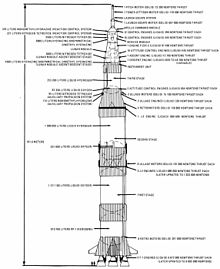

This article does not cite any sources. Please help improve this articlebyadding citations to reliable sources. Unsourced material may be challenged and removed.
Find sources: "Ullage motor" – news · newspapers · books · scholar · JSTOR (June 2008) (Learn how and when to remove this message) |
Ullage motors (also known as ullage enginesor ullage rockets) are relatively small, independently-fueled rocket engines that may be fired to accelerate the rocket prior to main engine ignition, when the vehicle is in a zero-g situation.

Liquid, cryogenic rockets keep their propellant in tanks. These tanks are never completely filled in order to allow for the expansion of the cold liquid propellant. In micro-gravity conditions the ullage gas may float around and threaten to be sucked into the engines, which is typically very undesirable. Small rocket engines, called ullage motors, are sometimes used to settle the propellant prior to the main engine ignition. These motors give an acceleration that moves the main engine liquid propellants to the bottom of their tanks so they can be pumped and possibly further into the pump and engine plumbing to initiate them, while the ullage gas floats to the top away from the engine inlets. Such motors were first invented by Soviet engineers for the Molniya interplanetary launch vehicle in 1960.
The firing of the ullage motors is used during stage separation of rocket and/or stabilization of a rocket when there are brief reductions in acceleration which could allow the liquid propellant to float away from the engine intakes. Ullage motors are also commonly employed on deep-space missions where a liquid rocket needs to start a burn after traveling in micro-gravity for some time.
Ullage motors are typically very small; research[who?] shows that only milli-gee accelerations are needed to avoid excessive gas intake. Some vehicles use other techniques to hold liquid at the inlet, as once the main engines are lit, ullage motors are no longer required.
The four ullage motors of the Saturn V rocket used in the American Apollo program were located on the second stage. In the third stage (known as S-IVB), there was a more general Auxiliary Propulsion System that also had ullage functions.